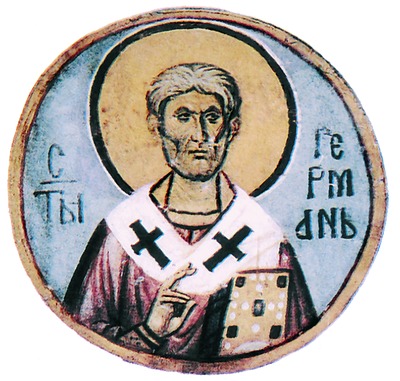St. Germanus I
Patriarch of Constantinople (715-30), b. at Constantinople towards the end of the reign of Emperor Heraclius (610-41); d. there 733 or 740. The son of Justinianus, a patrician, Germanus dedicated himself to the service of the Church and became a cleric at the cathedral of the metropolis. Some time after the death of his father, who had filled various high official positions, at the hands of the nephew of Heraclius, Germanus was consecrated Bishop of Cyzicus, but the exact year of his elevation is not known. According to Theophanes and Nicephorus, he was present in this capacity at the Synod of Constantinople held in 712 at the insistance of the new emperor, Philippicus, who favoured Monothelitism. The object of the council was to re-establish Monothelitism and to condemn the Acts of the Sixth General Council of 681. Even Germanus is said to have bowed to the imperial will, with the majority of the Greek bishops (Mansi, Conc. Coll., XII, 192-96). However, immediately after the dethronement of Emperor Philippicus (713) his successor, Anastasius II, restored orthodoxy, and Monothelitism was now definitively banished from the Byzantine Empire. If Germanus really yielded for a short time to the false teachings of the Monothelites, he now once more acknowledged the orthodox definition of the two wills in Christ. John, Patriarch of Constantinople, appointed by Philippicus to succeed the deposed Cyrus, sent to Pope Constantine a letter of submission and accepted the true doctrine of the Church promulgated at the Council of 681, whereupon he was recognized by the pope as Patriarch of Constantinople. On his death Germanus was raised to the patriarchal see (715), which he held until 730. Immediately (715 or 716) he convened at Constantinople a synod of Greek bishops, who acknowledged and proclaimed anew the doctrine of the two wills and the two operations in Christ, and placed under anathema Sergius, Cyrus, and the other leaders of Monothelism (q.v.).
Germanus entered into communication with the Armenian Monophysites, with a view to restoring them to unity with the Church, but without success. Soon after his elevation to the patriarchal dignity the Iconoclastic storm burst forth in the Byzantine Church, Leo III the Isaurian, who was opposed to the veneration of images having just acceded to the imperial throne (716). Bishop Constantine of Nacoleia in Phrygia, who like some other bishops of the empire condemned the veneration of the pictures and images of Christ and the saints, went to Constantinople, and entered into a discussion with Germanus on the subject. The patriarch represented the traditional use of the Church, and sought to convince Constantine of the propriety of reverencing images. Apparently he was converted to the teaching of the patriarch, but he did not deliver the letter entrusted to him by Germanus for the Metropolitan of Synnada, for which he was excommunicated. At the same time the learned patriarch wrote to Bishop Thomas of Claudiopolis, another Iconoclast, and developed in detail the sound principles underlying the reverencing of images, as against the recent innovations. Emperor Leo III, however, did not recede from his position, and everywhere encouraged the iconoclasts. In a volcanic eruption between the islands of Thera and Therasia he saw a Divine judgment for the idolatry of image- worship, and in an edict (726) explained that Christian images had taken the place of idols, and the venerators of images were idolaters, since, according to the law of God (Ex., xx, 4), no product of the hand of man may be adored. Immediately afterwards, the first Iconoclastic disturbances broke out in Constantinople. The Patriarch Germanus vigorously opposed the emperor, and sought to convert him to a truer view of things, whereupon Leo attempted to depose him. Germanus turned to Pope Gregory II (729), who in a lengthy epistle praised his zeal and steadfastness. The emperor in 730 summoned the council before which Germanus was cited to subscribe to an imperial decree prohibiting images. He resolutely refused, and was thereupon compelled to resign his patriarchal office, being succeeded by the pliant Anastasius. Germanus withdrew to the home of his family, where he died some years later at an advanced age. The Ecumenical Council of Nicaea (787) bestowed high praise on Germanus, who is venerated as a saint in both the Greek and the Latin Church. His feast is celebrated on 12 May. Several writings of Germanus have been preserved (Migne, P.G., XCVIII, 39-454), viz., “Narratio de sanctis synodis”, a dialogue “De vitae termino”, a letter to the Armenians, and three letters on the reverencing of images, as well as nine discourses in the extravagant rhetorical style of the later Byzantines. Of doubtful authenticity is the “Historia ecclesiastica et mystica”, also attributed to him (Migne, loc. cit., 383-454).
PARGOIRE, L’Eglise Byzantine de 527 a 847 (paris, 1905; HURTER, Nomenclator; KRUMBACHER, Gesch. der byzantinishcen Litteratur (2nd ed., Munich, 1897), 66 sqq.; HEFELE, Konziliengesch., 2nd ed., III, 363 sqq., 380 sq.; HERGENROTHER AND KIRSCH, Kirchengeschichte, 4th ed., II, 6, 16-17, 266.
J.P. KIRSCH (Catholic Encyclopedia)










